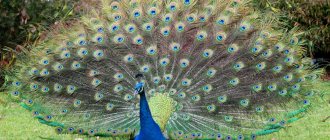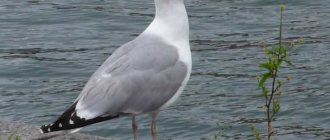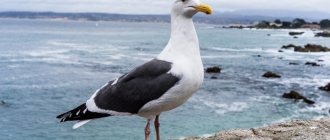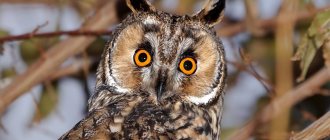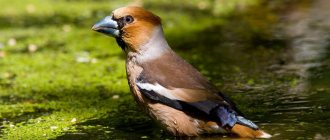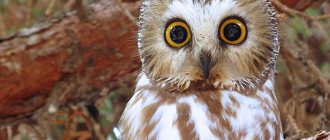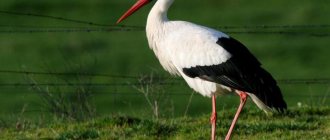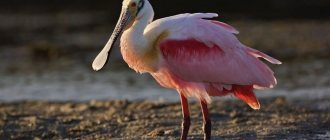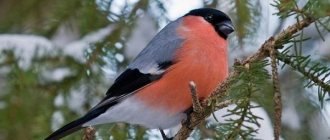Among the huge variety of birds (more than 9,800 species live on planet Earth), there are many delightful ones that attract attention and evoke delight and admiration for their unusual and amazingly beautiful appearance. There are many such birds in the tropics of southern countries. But in other parts of the Earth there are relatively rare and unusual specimens that attract attention. Some information about some of them is presented in this article.
Yellow color is atypical for birds living in Russia and neighboring countries, since many predators live in these areas. Such a bright color unmasks birds, especially in the snow. Therefore, many can identify and name not all birds with a yellow breast (or belly) that live in these places. Few species of birds of this color can be seen in the territory of the former CIS.
What are the birds with a yellow belly called? Where can they be found and what is their way of life? We will try to figure this out further.
Common oatmeal
This is a rather small bird belonging to the bunting family. It is similar in size to a sparrow, but its tail is longer. The body length reaches up to 20 centimeters, the wingspan is up to 30 cm. In Russia, few people know this beautiful bird, since its habitat is Baikal and some areas of Siberia. It should be noted that the common bunting has not only a yellow breast, but also a head. And one of the subspecies, the yellow-throated bunting, which once lived in Primorye, also has a peculiar crest.
The most real bird with a yellow belly is a male bunting. During the mating season, it is distinguished by feathers of golden-yellow tones located on the head, belly, chest, cheeks and chin. On the chest there are numerous streaks of a grayish-olive hue in the upper part and reddish-chestnut in the lower part. The back is grayish-chestnut with dark longitudinal streaks. The wings are painted brown. The beak is short but massive.
The female is generally similar to the male, however, her color is duller. Yellow tones have a slight greenish tint, and instead of brown, brown predominates. All young birds look like females. Buntings fly in waves, making several jerks.
Blue-headed magnificent bird of paradise (Cicinnurus respublica)
This bird of paradise species is simply stunning! The blue-headed magnificent bird of paradise is endemic to the lowland rainforests of Waigeo and Batanta Islands. There aren't many birds out there that present such a magnificent mixture of colors as this one.
Males have a bluish head with beautiful black patterns, a turquoise crest, black upper wings, a yellow mantle and blue legs. Their tail is not that long. But the curved shape and beautiful purple coloration are so unique among the bird family that we simply could not pass up this species.
Females do not have such bright feathers as males. To attract the female's attention, the male performs an exceptional courtship display. First he cleanses the earth to make this ritual as bright as possible. When the female appears, the male begins to show off his bright feathers, head, tail and sparkling green mouth.
Features of oatmeal
This amazing bird sings like a nightingale. The number of trills can often reach up to 300 species in one hour. The bunting surpasses almost all known birds in its musicality.
This bird feeds mostly on plant foods. Even in summer, she does not pay any attention to insects. The diet consists of plantain seeds, oats, wheat, and tree buds. And yet, oatmeal violates the rules of its “fasting”. This only happens during the breeding season. The female needs better nutrition at this time. It feeds on spiders, woodlice and small slugs.
This bird with a yellow belly lives in the wild, and therefore its life expectancy is approximately 3 years. There are cases where individual specimens living in captivity lived up to 13 years.
Reproduction of waxwings
Most often, waxwings nest in open forests, starting in May. They build cup-shaped nests closer to the tops of old trees, using all surrounding materials - branches, moss, grass. The inside of the nest is lined with pine needles, birch bark and lichen.
Pairs of waxwings nest close to each other, which is associated with a gregarious lifestyle. In one clutch there are 4-6 bluish speckled eggs, from which chicks hatch after 2 weeks. Responsibilities are strictly distributed - the male gets food, and the female incubates the clutch. But the hatched chicks are fed by both.
Photo: pinterest.ru
Dubrovnik
Another bird from the Bunting family lives in Northern Europe and Northern Asia. Its weight is 25 g, length – up to 17 centimeters, wingspan – 24 cm.
Due to its unusually bright plumage, the Dubrovnik resembles tropical birds. In summer, the head of males is almost black, the chest and throat are yellow. The back is brown, the belly is very bright yellow. There is a narrow chocolate-colored “collar” on the chest. Females have a brownish tint, with a yellowish belly and dark streaks on the sides and back.
Typical habitats are floodplains overgrown with shrubs, as well as meadows and forest edges with dense and tall herbs. Birds with a yellow belly fly to Southeast Asia for the winter. Her song is similar to ringing flute whistles.
Greater lyrebird (Menura novaehollandiae)
photo David Cook
The great lyrebird is a bird with unusually long tail feathers. This magnificent species is native to the rainforests of South-East Australia. This is a large bird where the males have very long tails. To reach its maximum length, the bird's tail grows for seven years and is about 70 cm long.
This amazing tail of the Great Lyrebird has sixteen feathers. Interestingly, these long feathers form the shape of a lyre (a stringed musical instrument). During courtship, males display these beautiful feathers to attract females.
Tit
This rather beautiful bird with a yellow belly can be found not only in Russia. It lives in both Central Asia and Europe.
The back of the tit is colored yellowish-green, the abdominal part is yellow. A wide black stripe runs along the chest and belly. It should be noted that the birds of this species of Central Asia have some differences - their plumage has a more bluish-gray tint. The top of the head, throat, sides of the neck and part of the crop of Russian tits are shiny black, and the sides of the head are white. The wings are grayish-blue with a transverse light stripe. The tail is almost black with a bluish tinge. These yellow birds are big for their family. They reach a length of up to 13 cm, and their weight is about 20 grams.
The tit is not a migratory bird. It remains in its habitat throughout the winter, and only in extreme cold does it move closer to humans (this makes it easier to feed). For your information: in ancient times in Rus' there was a decree that imposed a considerable fine on anyone who attempted the life of this beautiful bird.
Golden pheasant
The golden pheasant is an incredibly beautiful bright bird. Their males are more colorful than their females. They have a golden crest, bright red underparts, a yellow back, a shiny orange collar edged with black, and a long tail in shades of brown. This tail makes up almost two-thirds of the pheasant's length. Such a colorful bird may seem easy to spot, but in reality it is very difficult to see in the wild.
Interesting facts about the tit
There are many interesting facts associated with this bird with a yellow belly (photo in the article).
- Tits often hunt small dwarf pipistrelle bats (bats), which are poorly intelligent and quite inactive after hibernation. The bird hits them in the head with its beak, and then eats all the insides.
- The tit is a cunning bird. She herself does not stock up on food for the winter, but she skillfully finds it from other birds.
- The most fearless and curious after forty are tits. They may well even attack a person if there is a danger to their offspring. And at the same time, this bird can be safely hand-fed.
- Tit parents share the responsibilities of feeding and raising the chicks equally. These gray birds with yellow bellies quickly raise their babies on the wing.
Liddogesia
When it comes to unusual feather designs, Loddigesia mirabilis sets the bar pretty high. And this despite the fact that they do not have many feathers in their tail. Males have only four tail feathers, two of which are elongated, cross over and end in bright purple discs that look like a shovel or a tennis racket. The feathers are used to distinguish themselves from other birds.
Habitats and lifestyle of tits
Tits love to live in deciduous forests, in thickets along the banks of ponds and rivers, in parks, gardens and groves.
This bird is considered sedentary, but partially nomadic. This usually happens at the end of November and beginning of December. They return to their native lands in February and early March. In warm periods they feed on insects, in winter on seeds and tree buds. Adult tits watch their chicks very well. They bring food for them 31 times in one hour.
Singing titmouses
The tit is a noble songbird. The vocal male sings almost all year round; his loud chime is not heard only from November to January. At the end of winter and thaw, tits begin to sing simple tunes and rhythmically repeat their ringing tsi-tsi-fi and tsu-vi-tsu. Experts distinguish up to 40 variants of sounds made by tits; one individual can show from 3 to 5 songs in turn. The song sounds when the bird is excited, it is a means of communication in pairs. There is also a sub-song, like a quiet chirping, that sounds in February or March.
Yellow wagtail
This small bird with a yellow belly is the smallest representative of its genus. Its weight is approximately 17 g with a body length of about 16 cm.
The yellow wagtail (pliska) is a small, slender bird belonging to the wagtail family. It lives in vast areas of Asia, Europe, Alaska and Africa. It stands out, like other types of wagtails, by its long tail, which constantly swings from side to side. A special feature is the bright yellow plumage in the abdominal area of adult birds (especially in males). It can often be observed in damp meadows or along the banks of reservoirs. She usually sits on the top of a stem of tall grass, constantly balancing with her widely spread tail.
The gray-green or gray-brown color of the feathers on the back is characteristic of females and males, but females are slightly duller. The light brown flight feathers are edged in the form of an ocher-colored stripe. The tail is dark brown, with tail feathers along the edges painted white. Above the eyes there are horizontal white stripes. Legs almost black.
Red-tailed buzzard (Buteo jamaicensis)
photo Mark Heatherington
The red-tailed buzzard is found throughout North America. You can see these magnificent birds soaring high in the sky. In addition to its majestic appearance and wide wings, the red-tailed buzzard can impress with the beauty of its tail. The tail of these birds is short but wide. As the name suggests, the tail has a beautiful brick color. The color of other parts of the buzzard's body is as beautiful as its tail.
Wagtail lifestyle and nutrition
This small bird with a yellow belly lives in swamps with bushes and wet meadows, as well as in low forests and river valleys. The yellow wagtail almost never settles in the taiga, but lives along the banks of taiga rivers. Their behavior is similar to the behavior of white wagtails, but unlike the latter, yellow ones look for food not in the air, but on the ground, moving quickly and deftly along it. The diet includes small insects (flies, mosquitoes, butterflies, spiders, ants, bedbugs). In addition, this bird flies beautifully at low altitudes.
The yellow wagtail is a migratory bird. Throughout the summer, she leads a nomadic lifestyle, and these movements begin immediately after the chicks begin to fly. From this moment on, wagtails fly from place to place, and this continues until the period of departure for the winter. Birds migrate south (South and Central Africa), gathering in flocks. The flight altitude is 50 meters. The birds reach their wintering grounds by early November.
American blue jay
This blue-winged bird can be found in the central regions of the United States. It inhabits mixed pine, beech and oak forests. Sometimes they settle near human habitation, where they feed on food waste in addition to their main food. The main tone of the feathers of these birds is bluish-blue, with a black stripe on the neck and white specks located throughout the body. The nests of these jays are very strong and neat structures that the birds build from branches and pieces of lichen. Inside they are covered with wool, reinforced with earth and wet clay.
What does the chough eat?
These birds are very trusting. They often pick up food on the tops of mountains, where climbers throw it, and near mountain huts. Choughs usually do not fly away for the winter, but in the mountains their colonies become empty because the birds descend to the foothills and valleys. Choughs found in Spain, usually nesting in the walls of houses (both in ruins and in residential areas), are not as timid as in mountainous areas. And they often obtain food near human habitation.
Compared to other birds, whose food preferences and methods of obtaining food are quite diverse, the chough is mostly a consumer of small insects, primarily ants. This relatively small bird with a red beak also eats worms, seeds and berries.
Choughs usually feed in small flocks. In this important process, they are well assisted by their long, thin beaks, which extract small prey from grass or turf (remnants from rabbits and sheep).
LiveInternetLiveInternet
This conclusion was reached by zoologists who studied mating behavior in more than 150 individuals. The experiment was as follows. First, scientists used a series of behavioral tests to evaluate the character of the experimental birds. The subject of special attention was the presence of an “exploratory streak,” that is, how inclined finches were to explore new territories and what their reaction was to unfamiliar objects, whether they aroused indifference, fear or interest in the birds. After this, the females were given the opportunity to observe two potential suitors who were engaged in “research”, namely, in front of the “girls” they were studying an unfamiliar cage. At the same time, the males were placed in unequal conditions: one received a room for study, partly hidden from the female’s view, that is, she could not fully assess the male’s behavior. Then the female, who had seen enough of it, and both researchers were collected in one cage.
Females, distinguished by courage and curiosity, chose males prone to exploratory behavior as mating partners. But, what is noteworthy, the choice did not depend on the size of the body and the shape and color of the beak, that is, characteristics that usually serve as criteria for sexual selection in finches (and in birds in general). Less active females did not show such choosiness in choosing a male.
Of course, any of you will say that in “this matter” appearance does not decide anything, the main thing is that “the person is good.” In other words, a life partner should be chosen not by the color of lipstick or the aroma of perfume, but by character, by personal qualities. But this is the first evidence of such behavior in the animal kingdom; Until now, it was believed that the color and size of, say, a peacock's tail are more important than the high moral qualities of its owner.
However, before this there was already evidence that the same finches have a better chance of raising offspring if both parents are the same in character and have an exploratory streak (obviously, such individuals are better at looking for food for the chicks). But the significance of such “personal criteria” in relation to the choice of a marriage partner has not yet been noted by anyone. Most likely, scientists believe, similar behavior can be found in other animals, especially those prone to monogamy.
The zebra finch is one of the most common caged birds. This small, agile bird with a bright red beak is native to Australia. Under natural conditions, zebra finches lead a gregarious lifestyle, flying to feed and drink in groups of 50-70 individuals.
When kept at home, they certainly attract attention. Constantly busy with something, calling to each other and bullying even their larger neighbors, these finches greatly enliven an aviary with small birds.
The color of wild zebra finches is gray, the male has a black and white “vest” on his chest, yellow-orange cheeks, and a coral-red beak. Females are much more modestly colored: the top of the body is gray, the bottom is dirty white, the beak is carrot-colored.
Over a long period of cage keeping of this species, amateur breeders have developed many color variations of the zebra finch.
White . The birds are pure white, with dark eyes, red beak and legs. The male has a coral-red beak, while the female has an orange or carrot-colored beak.
Marmazet . Almost white birds with a slightly creamy tint. The eyes have dark stripes, and transverse, highly lightened stripes are visible on the tail. The male has orange spots on his cheeks, brown sides with white spots, a “vest” on his chest, but the black color is lightened to dark gray, and the beak is red. The female has no orange spots on her cheeks, no vest and no colored feathers on her sides. The beak is orange-red.
Fawn . The coloring is the same as that of the wild form, but the gray color is replaced by fawn of varying degrees of intensity. Sexual dimorphism is expressed as in the wild form, but in the male the black color on the chest and tail is replaced by dark brown.
"Penguin" . Birds with strictly demarcated colors on the top and bottom of the body. The color is dark above, white below, and the beak is red. Motley. Asymmetrically located white spots on a dark background or, conversely, a red beak.
Silver . Birds are light gray, silver in color. Significantly lighter than the wild form. The remaining differences between birds by sex are the same as in the wild form, i.e. the male has a redder beak, a “vest” on the chest, silvery spots on the cheeks and spotted sides. The female has none of this and has a lighter beak. Females and males have a light yellow rump; there are no transverse stripes on the tail.
Black-breasted . Similar in color to the wild form, the spots on the cheeks are much larger, the black stripe on the upper part of the breast is not 3 - 4 mm wide, but approximately twice as wide. Differences in the color of birds by sex remain. The colors of this form are gray, fawn and marmazet.
Crested . Includes all of the above color variations; there is a rosette-shaped crest on the head. A poorly developed crest resembles horns on one or both sides of the head. Sexual dimorphism in color, as in previous forms.
Feeding zebra finches in a cage is not difficult. It is similar to feeding Japanese finches, only it is necessary to give animal food a little more often and provide the opportunity to swim, which these birds especially love. They should be regularly given two or three mealworms or a handful of bloodworms, increasing the amount while feeding the chicks.
In their homeland, they nest in small colonies - 10 - 20 pairs, so if you have a sufficiently spacious room for breeding at home, a couple of birds do not need to be placed in a separate cage.
The cage size for a pair of zebra finches is recommended to be at least 60x30x40 cm. If the size of the enclosure allows, several nesting houses are hung in it (the shape and size of the houses are the same as when breeding Japanese finches).
The house is attached to the outside of the cage (there is usually a door on one of the side walls of the cage for this purpose). A bunch of dry hay or bast sponge is placed inside the cage or enclosure. Birds use this material to build a spherical nest in the house. During this period, it is a good idea to give them several soft feathers, preferably light in color, with which the birds line the nesting chamber. You can use pre-disinfected chicken or pigeon feathers.
3-7 days after completion of the nest, the female lays her first egg. Usually there are four to six eggs in a clutch, but young females nesting for the first time can lay two or three eggs.
The female lays an egg per day and begins incubation by laying the second or third egg. During this period, it is necessary to provide the birds with maximum peace: do not make noise near the cage, do not make sudden movements, and especially do not look into the house.
Zebra finches, unlike Japanese finches, are very sensitive and, if disturbed during nesting, can stop incubating the clutch or even stop feeding the chicks. If this happens, the eggs or chicks not yet covered with feathers can be transferred to Japanese finches that are in the same stage of reproduction.
The chicks hatch on the 14-15th day of incubation. They are covered with long fluff, the color of which determines the future color of the bird. Light-colored chicks (white and marmazet) are covered with light fluff, while dark-colored chicks are covered with gray down. At the corners of their beak, phosphorescent bluish thickenings are visible - ridges that help parents find them in the semi-darkness of the nest. The chick's open mouth looks like an exotic flower: there are several black dots on the yellow background of the mouth cavity.
Chicks grow very quickly, and at this time it is necessary to increase the amount of soft food.
On the 22-25th day, the chicks leave the nest, but the parents feed them for a few more days, after which they begin to prepare for the next clutch. If this happens in a cage, then the chicks should be separated from their parents, since the entire territory of the cage “belongs” to the nesting pair, and the already independent chicks of the first brood become unwanted competitors. Otherwise, their parents may pluck them or chase them to death.
In spacious enclosures, this, as a rule, does not happen - adult birds only drive the chicks away from their nest.
At the age of up to one and a half months, young birds have a black beak and the same dull coloration as the females of this species. From one and a half months, the beak begins to turn red from base to tip, and by two and a half months it is almost entirely orange-red, only at the very tip there remains a black area. Young males are already actively singing, colored feathers appear on their sides and cheeks, and a “vest” appears on their chest.
Zebra finches, due to the ease of their breeding and unpretentiousness, are loved not only by avid poultry farmers, but also by beginners in this business. This species of weaver (Taeniopygia guttata) is native to the plains of Australia. During dry periods, zebra finches lead a gregarious lifestyle, making long flights in search of food and water. And during rains and sufficient moisture, they build nests and actively reproduce, sometimes even from 1.5 months of age.
Zebra finches got their name because of their coloring: the neck and chest of males have characteristic black and gray transverse stripes. In the classic (natural) version, the males of these birds have ash-colored plumage on the head, neck and upper back. On the black feathers of their tails they have large and white spots, and on their red sides there are small, scattered spots. The cheeks have a dark orange round “blush”. In general, the body coloration is in shades of brown and brown; there is a dark mark on the chest. The paws are carrot-colored, and the beak is painted deep red.
of this species of finches are distinguished by more modest plumage colors and the absence of zebra stripes. They are dusty gray, with dark stripes on the tail and around the eyes. The females have carrot-colored paws and a red beak. They do not have an orange “blush”. Up to 2 - 3 months, male chicks are colored almost like females, and all young individuals have a dark beak color. After changing their “outfit,” male and female zebra finches are easy to distinguish. Adults grow up to 11 cm.
Puberty in these birds occurs very early. Zebra finches form permanent pairs and build a nest of an oblong, bottle-like shape. They build it for about a week - from thin hay and blades of grass, covering the inside with feathers. In captivity, birds are offered a nesting house (approximately 12x12x20 cm) with a slot opening and dry grassy material for its arrangement. A clutch of zebra finches can contain 4 - 7 eggs, incubated by both partners for 1.5 - 2 weeks. At the age of about 20 days, small finches leave the nest, but their parents can feed them for some time.
Breeders have bred many zebra finches that have a color atypical for the wild. There are white, silver, brown, masked, penguin, piebald and even hybrids with other species. However, it is natural zebra finches that have the brightest, most contrasting plumage and good reproductive qualities.
When breeding at home, it should be taken into account that these birds are quite conflicting. They do not tolerate neighbors in a small area and prefer to live in a separate cage, in pairs. This is especially evident during the breeding season. Zebra finches feed on a grain mixture, in addition to which they are also given soft and juicy food, mineral supplements and cereals.
For breeding birds, I chose a male zebra finch of natural coloring, in whose family there were only birds of natural coloring.
The female also acquired a natural color, but her pedigree had individuals of natural, white and fawn colors. The calculation was simple: the most beautiful males are of natural color, and I wanted that, with possible direct inheritance, they would be born only in this color. Females with natural colors are less decorative (plain gray), so white and fawn pairs look more preferable. I consider the most suitable cage for keeping a pair to be the one with the optimal dimensions: 350x210x260 mm, in which canaries are usually kept, photo. 1 Photo 1
Click on the photo to enlarge I equip the cage with three sticks-perches made from dry branches of an American maple.
Such perches are light, less hard (compared to other types of wood), which prevents injury to the birds’ feet, and they can also be easily processed with a knife. The diameter of the perches is chosen so that the bird does not completely cover them with its toes. Zebra finches love to swim and splash like ducks, so it is better to equip their home with a standard removable bathing suit that is attached to the outside of the cage. However, those swimsuits that are sold in pet stores have to be modified with homemade pins for attaching to the home, Fig. 1 Fig. 1.
1-pins (4 pcs.) - pieces of tinned copper wire Zh1 mm., are fused into a plastic case using the tip of a heated soldering iron. Click on the picture to enlarge I also use a standard small drinking bowl due to the small size of the birds.
My bird breeder friends have had cases where birds, dipping their heads into a deep jar of water to drink, fell into it and died. The standard drinking bowl fits well into the cage grille from the outside, making it easy to change the water. I make the nest house from planks 10 mm thick, dimensions 150x100x100mm. I make the top lid openable so you can see what’s going on in the nest. By placing a thin stick between the vertical walls and the lid and moving it, you can adjust the air gap as the chicks grow older. The gap, of course, should not exceed 12 mm, otherwise the birds may fly out of the cage through it. The gap is fixed using two screws and wire, Fig. 2. Fig.2. Little house. 1-pins for fastening to the cage (tinned copper wire Zh2 mm.); 2-stick for adjusting the air gap; 3-screws; 4-arrival hole (3.5x5 cm) Click on the picture to enlarge I fill the bottom of the cage with washed water and dried sand.
I also use a knife to shave small particles of activated carbon and chalk onto the bottom; for this I have pieces of chalk and charcoal. Activated charcoal can be bought at the pharmacy, but it is also quite easy to make it yourself. I make a fire on the ground from chopped dry birch firewood. As soon as smoldering coals form, I cover the heat with a tin bucket to prevent further access of air to the coal. I sprinkle the edges of the bucket with sand. The bucket should not have a zinc coating, in order to avoid zinc salts getting into the coal; uncoated or tinned with tin is suitable. When the coals have cooled, I clean the pieces from the top layer of dust (ash) and place them in a polyethylene bag. One small burnt log lasts for several years. It is not advisable to use coniferous wood due to the resin content. It is advisable to have sand of different fractions according to the grain size of 0.2-1 mm. A family of birds released into an equipped cage immediately begins an examination: at the bottom they select particles of sand, coal, and chalk to improve the digestion of food, examine the house and immediately begin to swim.
After a few days, the birds show increased interest in each other and mate. Leek grass, picked in early June and cut with scissors into pieces 15-20 mm long, is well suited as a material for a nest.
Young dried grass is soft and does not have sharp fibers that can cause trouble for birds. I place such nesting material in the house a few days later, when the birds have already mastered the home; otherwise the rustling of grass in an undeveloped house may frighten them, and they will ignore the nest. To repel parasites, I mix pieces of grass with dried chamomile flowers. At the bottom of the cage I put dried dandelion leaves and tradescantia, which the finches immediately transfer to the nest. I consider adding bird fluff to build a nest inappropriate: firstly, the house is already warm; secondly, when the chicks hatch, the down becomes clogged with droppings; thirdly, the stray fluff of the nest attracts ticks, which are brought into the apartment with soil for indoor flowers, on the soles of shoes, fruits, vegetables, herbs... The appearance of parasitic insects is a scourge for birds. The parasites eat feather grease and fluff to such an extent that the bird can almost completely lose its downy covering, especially in the head part of the body, where finches do not have the opportunity to pick them out with their beaks. Usually, bald areas take a very long time to heal due to the fact that the fluff stumps remain in the body for a long time and it will take time for them to fall out, in fact, until the next molt. In such cases, the fight against parasitic insects will be long and painstaking, with treatment repeated several times over a period from a week to several months. I think that “Puldis” zoo powder in plastic packaging is effective for removing insects.
It is enough to spray the powder through the cage bars onto the bird and the bottom of the cage. Repeat treatment according to instructions. By the behavior of the birds, their playfulness, and gestures of gratitude (a friendly raising of their tufts), one can judge that they liked the housing.
The location of the home plays a big role in the life of indoor birds, so you need to carefully study the literature: where finches living in the wild are described, how they are bred, and to bring these conditions as close as possible. Usually the cage is installed in a bright place, but always away from drafts. Literally all exotic birds tolerate low temperatures quite well, but they quickly die from drafts. For the cage, I installed a low table near the window, about 80 cm high; the lid size is 70x70 cm. I placed the cage in the middle of the table surrounded by house plants, photo 2. Among them: bactericidal geranium, the smell of which is unbearable for insects, tradescantia, chlorophytum, etc. Knowing that weaver birds usually nest in separate bushes, this composition reminds them of natural conditions, and the corner of nature in the room turns out to be beautiful. For closer mutual understanding, you need to communicate with the birds as often as possible: “talk to them,” study their “language” - understand what they ask.
So, for example, fast movement along the perches with frequent chirping means a request for food, change of water in the bathing bowl, drinking bowl; vibration of the female's tail, distinctive sounds - a signal to the male for mating, etc. Finches are very curious, study every movement of the owner, perfectly remember his face and appearance, and greet him with delight. No birds rejoice at the coming day as much as finches. A cheerful, simple song creates a good mood for the whole day. It is good to hang a night light with a low power bulb above the table, for example, from a refrigerator; it is necessary when preparing the birds for the night. Photo 2
Click on the picture to enlarge Feeding birds is of great importance.
Having studied some literature, we can determine: the main food for finches is millet (preferably red). Just as an additive to the main food, I use canary seed, various cereals, and a chicken egg (hard-boiled). I definitely try dry food to taste it, there should be a taste of mold, rancidity, bitterness that is not typical for grain. There are many ways to prepare porridge, but I offer my own recipe, which I have been successfully practicing for several years. In a small bowl (preferably an enamel small saucepan) put one tablespoon with the top of washed rice, pour in 3/4 cup of water, add two teaspoons of dry milk, stir and cook until the rice grain begins to soften, then add two tablespoons of millet , add a small amount of iodized table salt, half a teaspoon of natural bee honey. When the mixture thickens, add a teaspoon of oatmeal. I mix the mixture thoroughly. Cook the porridge without a lid, with continuous stirring. Then I close the dish with a lid and wrap it in 2-3 towels, leaving it to steam. Cooled, properly cooked porridge can be easily separated into grains with a spoon. It should be stored in the refrigerator for no more than a week. For feeding, the porridge should be slightly warmed, for example, on a saucer over a gas burner, so that the birds do not catch a cold. Honey can be replaced with sugar, but powdered milk cannot be replaced with whole milk, in my experience; it may cause indigestion. This carbohydrate-protein-vitamin mixture will successfully replace your expensive Trill food. Chicken eggs, in my opinion, should be given to birds, but with great caution. We know that eggs that can be found in our markets, unfortunately, can be of very dubious quality. Of course, if it is possible to give birds eggs from domestic chickens, this will only be beneficial. Suitable green food includes dandelion leaf, wood lice, grated carrots, young shoots of millet, and oats. But do not forget that the greens must be thoroughly rinsed with water and dried a little. The basic food norm I established for one pair of finches per day is:
- 3 teaspoons red millet;
- 2 teaspoons of porridge prepared according to the above recipe;
- 0.5 teaspoon canary seed (Trill).
When chicks appear, I always add pieces of homemade chicken eggs to the porridge to feed the young.
It’s good to sprinkle about a dozen bloodworms on the bottom of the cage during feeding, once a day. Usually finches do not pay attention to them, but during nesting they attack live worms and quickly eat them. Then the chicks are fed. As you can see, live food is desirable. In general, when feeding chicks, there should even be an excess of food, otherwise the parents, seeing that there is not enough food, can throw the chicks out of the nest, leaving one or two.
ZEBRA FINCH (Taeniopygia guttata), a bird of the weaver finch family. The male's top of the head, neck and front of the back are ash-gray. The front of the neck and chest have a fine cross-striped pattern. The “zebra” coloring is obtained through a combination of black and light stripes on the chest (hence the name). The upper tail coverts are black with white tips. The sides of the body are chestnut, with many white spots. The back and wings are gray-brown, the tail is dark brown. The beak is coral red, the legs are light orange. The female's plumage is less bright and lacks the zebra pattern on the throat and chest. The abdomen is slightly yellowish. In young individuals, the plumage has a brownish tint and the beak is black. The natural range of the zebra finch covers all of Australia, with the exception of the northernmost and southernmost regions of this continent. Lives on plains overgrown with grass, with single bushes and trees, likes to settle close to water. During the non-breeding period, it unites in flocks, making small migrations. It feeds on the seeds of grasses and other plants, collecting them on the ground. The bottle-shaped nest is built from plant fibers and hay, lining the inside with feathers. The clutch contains 3-6 eggs, white with a greenish tint. During drought, birds nest once a year or do not nest at all, but in a favorable year, nesting is repeated many times. After the chicks fly out of the nest, the parents continue to live in it. The couple lasts until the death of one of the partners. Zebra finches are characterized by rapid sexual maturation. In nature, their reproduction is noted at six weeks of age. This feature is due to the fact that in Australia dry periods occur chaotically, the drought can last for quite a long time, therefore, when a favorable period comes, the young from the first broods manage to breed offspring in the same season. They retain this ability in captivity, which made them suitable for mass breeding. The zebra finch is one of the most beloved indoor birds. It was brought to Europe from the Australian continent at the end of the 19th century and then domesticated. Over a relatively short period of domestication (about 100 years), many artificial breeds and colors have been developed, but the most beautiful and spectacular is the natural coloring of zebra finches. These small birds, much smaller than a canary, captivate with their pleasant decorative appearance and undemanding nature when it comes to food. The main food is millet, preferably light millet, since its skin is thinner. It is necessary to add lettuce and canary seed, chumiza, and mogar to it. In addition to the main food, you need to give a carrot mixture prepared in the same way as for insectivorous birds, chopped chicken eggs, fresh ant pupae, white bread in milk or water and greens.

